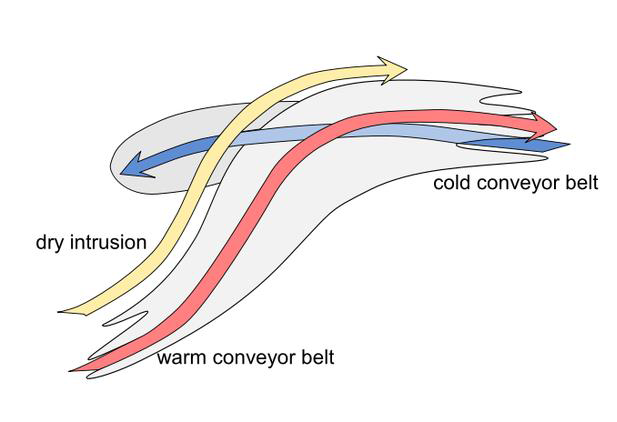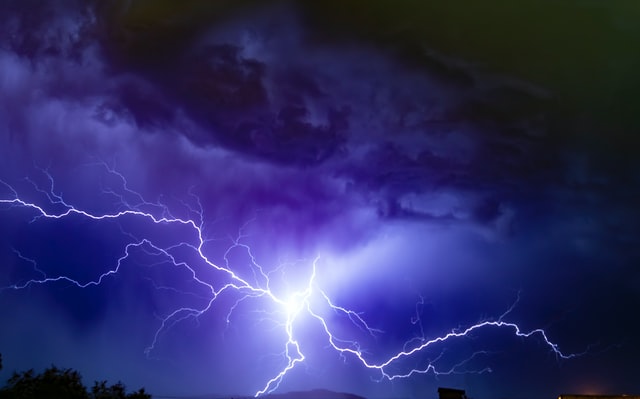Identify and interpret broad scale, synoptic and mesoscale systems
Presentation 4 from the Synoptic and Mesoscale Analysis of Satellite Images 2016
Length: 75 min
Author: Veronika Zwatz-Meise (former ZAMG)
Cyclogenesis and occlusion cloud bands are common meteorological phenomena which are tightly connected. While “cyclogenesis” is a process, describing the development of a low centre, which can last from few hours to several days, the occlusion cloud bands are the result of this cyclogenesis process. Occlusion cloud bands differ from cold and warm front bands because of their history as well as their physical status.
The two lectures start from the classical cyclogenesis (occlusion) processes which are related to the classical polar front theory and introduce then the conveyor belt view of these processes culminating in the warm and cold conveyor belt occlusion types.
The occlusion cloud band types are described and compared to cold and warm front types in their horizontal as well as vertical depiction.
Also special subtypes of occlusion processes like “instant occlusion” and “cold air development” are mentioned.
Presentation 3 from the Synoptic and Mesoscale Analysis of Satellite Images 2016
Length: 61 min
Author: Andreas Wirth and Liliane Hofer (ZAMG)
When observing the development of frontal zones in satellite imagery, forecasters should always keep an eye on frontal sub-structures like upper waves, front intensifications or rapid cyclogenesis. It is important to look for frontal substructures, because they often show new developments. NWP models sometimes catch the situation, sometimes not. Especially for rapid or small scale developments, model performance may leave a lot to be desired.
Here we focus on comparison of model outputs and satellite data regarding frontal substructures. Because the data are easily compared and show great results, satellite images are a good tool for model output verification.
Presentation 2 from the Synoptic and Mesoscale Analysis of Satellite Images 2016
Length: 52 min
Author: Ab Maas (former KNMI)
Fronts as described in the “Bergen school” by Vilhelm Bjerknes are early conceptual models. Parameters typical for the changing of air masses were named and used by forecasters to recognize transition zones (fronts) between air masses. Satellite information expressed how right Bjerknes was in his CM thinking, but this information showed also that fronts can have much more complicated structure and life cycle Bjerknes could imagine.
In SatManu there are 5 different types of cold- and 3 different types of warm fronts that are recognized and described.
In this lecture we concentrate on warm- and cold fronts and show how we can analyze them with help of CM thinking.
Presentation 1 from the Synoptic and Mesoscale Analysis of Satellite Images 2016
Length: 56 min
Author: Ab Maas (former KNMI)
Getting a good, actual weather picture within short time is essential for a forecaster who has to react quickly and adequately on weather changing’s.
The huge amount of weather data which are available makes it almost impossible for a human being to handle. Thinking in conceptual models is the only way to deal with this problem
Meteorological satellites opened a whole new field in the conceptual model thinking in operational meteorology. Now there was an opportunity to recognize weather systems by detecting cloud patterns and verify this first guesses with observations and numerical parameters.
Within 20 years of the project fifty-three different conceptual models were described in a manual: Sat Manu. Also for the southern hemisphere, we have already fifteen CM’s described.
Presentation 7 in the Environment Event Week 2016
Length: 50 min
Author: Mike Willmott (BOM)
Apart from the central desert areas, the Australian landscape, from the tropics of Far North Queensland to the southern tip of Tasmania has climatic conditions and vegetation which are conducive to wildfires throughout the year. The most volatile of these areas being the south eastern parts of Australia which includes the states of South Australia, Victoria, New South Wales and Tasmania. Australia has large tracts of wilderness which can only be monitored by aircraft and satellite and as such, remote sensing for bushfires within the landscape is virtually mandatory throughout the dry season in the tropics and the summer periods for the southern states. This talk looks at some of the ways that Satellite Remote Sensing has assisted emergency managers for preparedness, response and recovery, the three most important factors for any emergency operation.
In the frame of the 2020 SEEMET course, Andreas Wirth gave an overview talk on the conveyor belts theory.
Length: 15 minutes
In the frame of the 2020 SEEMET course, Andreas Wirth gave an overview talk on the conveyor belts theory. The three main conveyor belt types are explained and application examples are shown.
Andreas Wirth shows the main differences between the classical Norwegian cyclone model and the Shapiro-Keyser cyclone model.
Length: 110 minutes
In the frame of the 2020 SEEMET course, Andreas Wirth gave an overview talk on the two main mid-latitude low pressure systems: the classical Norwegian cyclone and the more recent Shapiro-Keyser cyclone. Both models were shown side by side and the main differences were pointed out. A real case example of both cyclone types illustrated the stages of the cyclones' life cycle. Finally, a quick overview was given on Sting Jets, a phenomenon that often accompanies Shapiro-Keyser cyclones.
In this presentation Tomaš Pučik and Christoph Gatzen explore different regimes under which ingredients come together and create marginal CAPE setups typical of winter
Forecasting deep-moist convection and lightning in winter is challenging, partly because it occurs outside the typical season and partly because it forms in the environments characterized by marginal buoyancy. Despite weak CAPE, winter time convective storms often pose a considerable severe weather risk given their frequent collocation with strong vertical wind shear. In this presentation we explore different regimes under which ingredients come together and create marginal CAPE setups typical of winter. These include synoptically strongly-forced situations, elevated storms and the lake-effect over the European seas.







